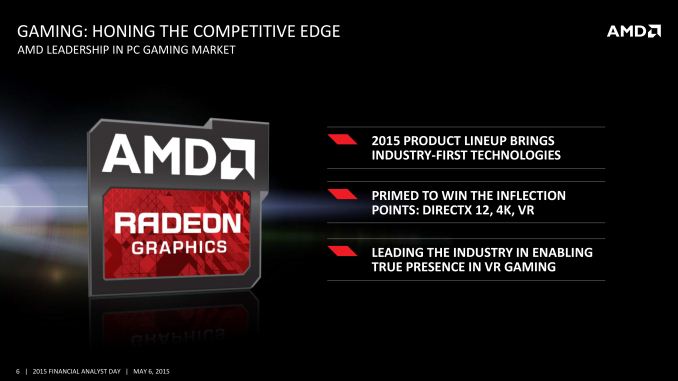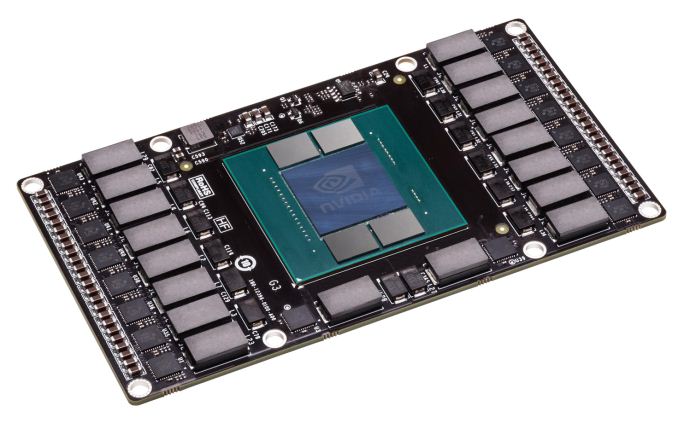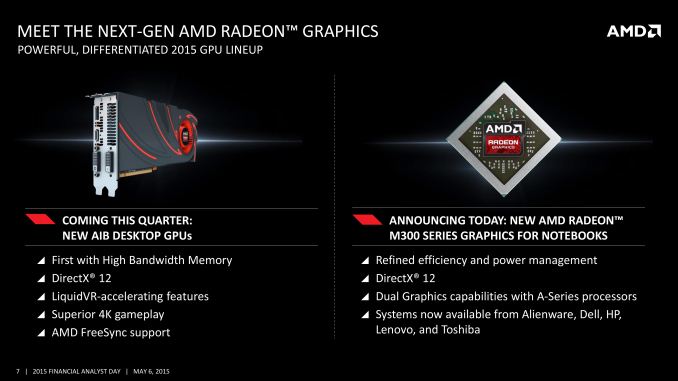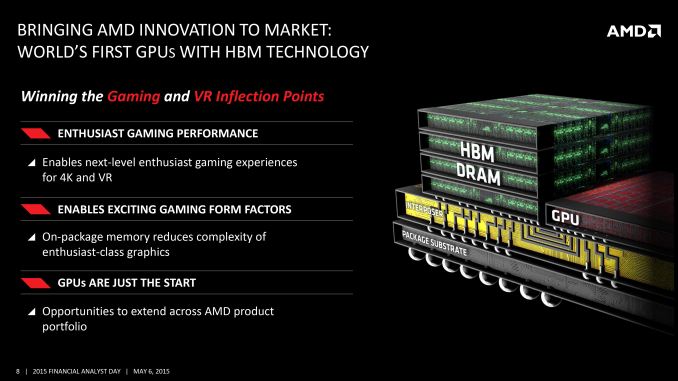AMD To Launch New Desktop GPU This Quarter (Q2’15) With HBM
by Ryan Smith on May 6, 2015 2:22 PM EST- Posted in
- GPUs
- AMD
- Radeon
- AMD FAD 2015

Having just left the stage at AMD’s financial analyst day is CEO Dr. Lisa Su, who was on stage to present an update on AMD’s computing and graphic business. As AMD has already previously discussed their technology roadmaps over the next two years earlier in this presentation, we’ll jump right into the new material.
Not mentioned in AMD’s GPU roadmap but now being mentioned by Dr. Su is confirmation that AMD will be launching new desktop GPUs this quarter. AMD is not saying much about these new products quite yet, though based on their description it does sound like we’re looking at high-performance products (and for anyone asking, the picture of the card is a placeholder; AMD doesn’t want to show any pictures of the real product quite yet). These new products will support DirectX 12, though I will caution against confusing that with Feature Level 12_x support until we know more.
Meanwhile the big news here is that these forthcoming GPUs will be the first AMD GPUs to support High Bandwidth Memory. AMD’s GPU roadmap coyly labels this as a 2016 technology, but in fact it is coming to GPUs in 2015. The advantage of going with HBM at this time is that it will allow AMD to greatly increase their memory bandwidth capabilities while bringing down power consumption. Coupled with the fact that any new GPU from AMD should also include AMD’s latest color compression technology, and the implication is that the effective increase in memory bandwidth should be quite large. For AMD, they see this as being one of the keys of delivering better 4K performance along with better VR performance.
In the process AMD has also confirmed that these HBM-equipped GPUs will allow them to experiment with new form factors. By placing the memory on the same package as the GPU, AMD will be able to save space and produce smaller cards, which will allow them to produce designs other than the traditional large 10”+ cards that are typical of high-end video cards. AMD competitor NVIDIA has been working on HBM as well and has already shown off a test vehicle for one such card design, so we have reason to expect that AMD will be capable of something similar.

With apologies to AMD: NVIDIA’s Pascal Test Vehicle, An Example Of A Smaller, Non-Traditional Video Card Design
Finally, while talking about HBM on GPUs, AMD is also strongly hinting that they intend to bring HBM to other products as well. Given their product portfolio, we consider this to be a pretty transparent hint that the company wants to build HBM-equipped APUs. AMD’s APUs have traditionally struggled to reach peak performance due to their lack of memory bandwidth – 128-bit DDR3 only goes so far – so HBM would be a natural extension to APUs.












146 Comments
View All Comments
dragonsqrrl - Wednesday, May 6, 2015 - link
"just someone has to release a monitor with a panel that supports those high rates.."I think you may have just answered your own question.
kyuu - Wednesday, May 6, 2015 - link
Don't bother arguing with chizow on anything related to AMD. They must have kicked his dog and raped his wife or something. That's the only way I can fathom his irrational viewpoint on anything relate to them.testbug00 - Thursday, May 7, 2015 - link
Freesync can, the "controversy" is about the fact that ASUS released/is releasing a 144Hz Freesync monitor where the Freesync range is only from 40-90Hz. Nothing to do with what Freesync does, everything to do with how ASUS chooses to implement Freesync.Krysto - Wednesday, May 6, 2015 - link
I hope to see some fast Vulkan support once the spec is out too, but considering AMD is kind of terrible with open source stuff, I'm not going to keep my hopes up.Pwnstar - Wednesday, May 6, 2015 - link
Like nVidia is much better:http://wccftech.com/nvidia-drivers-open-source-fri...
ZeDestructor - Wednesday, May 6, 2015 - link
At least Nvidia closed-source drivers work on *nix. With current versions of X. Can't say the same for AMD I'm afraid, though you're welcome to loan me a GCN-based AMD GPU.. the last AMD GPU I used was the 4650M, quite a long time ago.testbug00 - Thursday, May 7, 2015 - link
Vulkan is based heavily off of Mantle/PS4-code/XboxOne-code. Same for DX12. Now, there will certainly be differences and things they need to adapt to for both!der - Wednesday, May 6, 2015 - link
HBM all the wayyyyyyyyyy42 comment is love, 42th comment is life.
Refuge - Friday, May 8, 2015 - link
42nd*NinjaFlo - Thursday, May 7, 2015 - link
I've bothered to read all of the comments here and I've come to a couple of conclusions. Admittedly, I am a fan of Wintelvidia (can you call it this? lol), but still hold AMD in somewhat high regard. I'd like to just express some of my thoughts and see what you guys think - agree or disagree, enthusiastic or salty, I don't really care; just want to see people's reaction and thoughts.First, in relation to all the comments thus far, despite all of the people against @chizow, I gotta hand it to you: you have some big brass ones, inciting the wrath of all the AMD fanboys - though you were kind of being a dick about it.
Here are my conclusions, based on 'objective' viewpoints:
1) Does the product you seek to buy offer the performance you wish to achieve?
2) Does the product you have found meet those requirements at a reasonable [performance/power-consumption/thermal-output/noise] ratio?
3) Does the product you have chosen offer you stability in all areas of work and/or games?
4) Does the product you selected offer compatibility and/or support for other similar products?
5) Does the product you picked limit your upgrade path and/or satisfy it's intended life-cycle?
Everything else, including monetary/financial/pricing concerns, are subjective... which is where I think a lot of Nvidia and AMD fans disagree.
For myself, I set a goal - I must get 'at least' 1080p at 60FPS with at least High Quality settings. This can change for many people; when they choose* that they want to play at 1440p or 2160p, etc. Then I decide, what is the best product based on the goals I have set - which are not unreasonable goals. In fact, they are goals or criteria revolving around and founded upon the core concept of striving for efficiency. If I am being wasteful of my time, resources, effort, or energy, then I am not being efficient. And as an individual - whose preferences can be completely be different from another person's (who has every right to choose* what they want) - I value efficiency.
So when I look at a Radeon 290X, I can go "wow, that's pretty amazing for the price..." but then realize that it does not fulfill the requirements of Goals 2 and 3. Strictly-objectively speaking, the 290X runs too hot and consumes way too much power, even for something "last-gen". The same could have been said for Fermi's GTX 480, but it's 2015 now. We have seen over the last few years that Nvidia has improved my criteria of Goal 2, whereas AMD has succeeded in meeting Goal 1, but not 2 - thus risking 3. Where's the efficiency in that?
I have friends who have AMD builds who are happy about their purchase, and I respect them for that - and I understand why they are happy. Simply because they had different goals and criteria from my own. Instead of striving for strict efficiency, their goal was to stay within a price range and pick the best product within their limited range - and this is perfectly fine... though I would most often argue that efficiency will 90% of the time, get you the performance that you desire for a reasonable price. But it was their choice to go that route, and it was my choice to go mine. The difference between @chizow and I, is that he prefers to troll and I... well I like to troll too : D
I plan to upgrade to 4K before the end of this year, and I too, am holding out to see what AMD has too offer... so that Nvidia can release something I know will most likely release a product that will fulfill my demands/goals at a lower price-point than the Titan X. Back when the 295X2 was released, that was super tempting, but it still failed to meet 'rules' 2 and 3, while excelling in 4 (add 295X2 + 290X for Tri-CFX!? the temptation is real). But ultimately, I have reduced my build in physical size in my pursuit for quiet, small-footprint, and efficiently powerful performance. My current computer is a Mini-ITX Hadron Air build, running under 500W consumption, with a i5 4670K (4.4Ghz) with an H100i, 16GB (2x8GB) DDR3L 1600Mhz RAM, GTX 780 SC, 4TB Hard Drive, 2TB Hard Drive, and two SSDs of reasonable size. Don't ask me how I managed to fit an H100i and all that in there; no, it's not the Hydro version; it took a lot of time, effort, and planning, and was a pain in the arse to set up - but it was worth it.
In the end, I feel that we should push for efficiency, but if your system ends up different from mine because you had different criteria to meet, then that's fine by me...
... after all, that's what the glory of PC gaming is about. Building creatively and producing machines for fast-paced, higher-quality gaming, with the level of flexibility that you set, versus exclusivity-bricks that we call consoles.
#longlivepcmasterrace